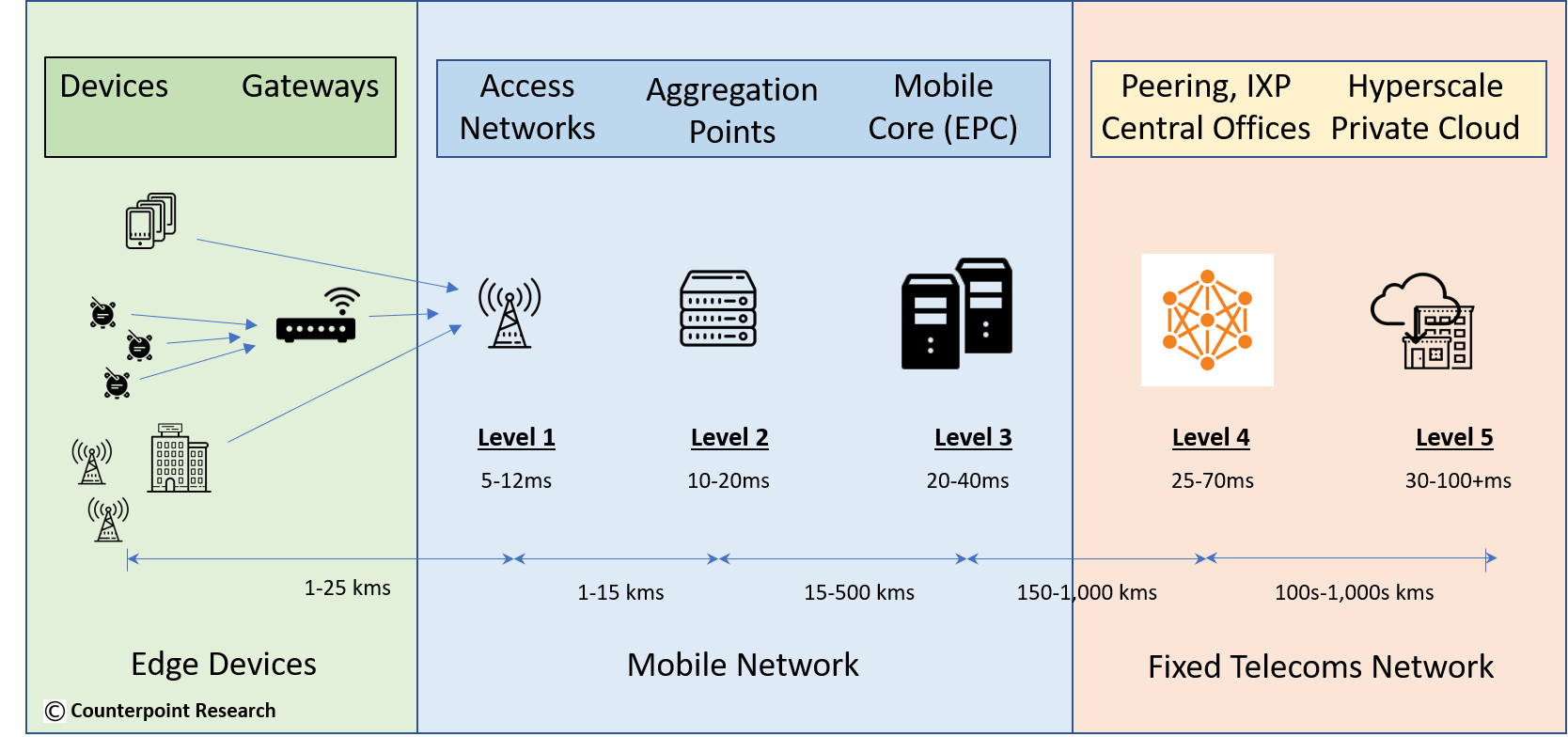One of the major promises of 5G is low latency, with target levels of 1 millisecond being specified for the air interface in 3GPP’s Release 16 document. Low latencies will enable Mobile Network Operators (MNO) to introduce a wealth of new applications and services. However, achieving these low latency levels will require them to build a dense network of Multi-Access Edge Computing (MEC) data centres at considerable cost and with significant business risk.
MEC Deployment Options
MEC platforms can be deployed at multiple locations in a network with the chosen location depending on various factors, including required performance criteria (for example, latency), physical deployment constraints, scalability and use case requirements. As shown in Exhibit 1, the most suitable locations are at the tower, network aggregation points, mobile core and central office sites.
- Level 1: Tower/Base Station – this is the closest point in the mobile network to the mobile user and, therefore, the one with minimal latency. However, often this may not be the best choice for several reasons, including power limitations (most cell sites are limited to 1-2 kW), the lack of fibre resources at individual tower locations and the increasing trend within the wireless industry to aggregate radio management at central locations, for example, at C-RAN hubs.
- Level 2: Network Aggregations Points – in a macro cellular network, possible locations include at multi Radio Access Technology (RAT) points, Service Access Points (SAPs) or at C-RAN hub sites. C-RAN hubs typically control around 30-40 cell sites and enable RTT latencies to and from the base station of around 10-20 milliseconds.
- Levels 3 and 4: EPC, Central Offices, etc. – in the case of incumbent MNOs/telcos, possible locations include EPC sites and fixed network nodes such as regional data centres (large central offices), local data centres (small central offices) or other aggregation sites.
Real-World Latency Levels
Although there is a lot of hype about the 1 millisecond latency target, the actual levels of latency in public 5G networks will depend on real world deployments. As a result, latency levels in the 10-12 millisecond range are more likely than 1-2 milliseconds and will probably require a heavy reliance on fibre and optical switching in the transport network. However, it is likely that single-digit millisecond delay times will be possible for URLLC[1] use cases running on private, industrial 5G networks, which are essentially controlled environments not subject to the typical traffic congestion issues within public 5G networks.
MEC Infrastructure Costs
Adding MEC will clearly increase the cost of 5G networks, with the actual costs depending on how it is implemented. The most expensive option will be if MEC is implemented at every tower location, with likely thousands of sites per MNO (Level 1). Deploying at RAN aggregation points or other Points of Presence (PoPs) would reduce the number of MEC sites from thousands to hundreds per MNO and cost significantly less. The most cost-effective solution, however, would be deployment at a few tens of EPC sites and large central office facilities (Levels 3/4). This is the option that most MNOs will likely adopt initially and is the preferred option of, for example, SK Telecom and Deutsche Telekom, both of whom launched limited commercial MEC services during 2019.
Exhibit 1: RTT Latency at various points along a 5G network

Other challenges may also drive MNOs towards the Levels 3/4 option. For example, the physical space available at many cell sites is limited and an adequate power supply to power the additional equipment may not be easily available. There will also be a higher risk of theft in some countries for MEC equipment which may result in higher security costs.
Central vs Distributed MEC Architecture
While it is likely that more applications will emerge that require sub-1 millisecond latency in the future, Counterpoint Research believes that the main focus in the short term will be on Layer 3/4 MEC data centres. MNOs should start by deploying MEC at Levels 3/4 locations and then progressively expand to Level 2 and finally to some Level 1 locations. In this way, MNOs can address new opportunities without needing to impose unachievable ROIs on their MEC business cases. Some MNOs may take a bold decision and adopt a much more distributed MEC architecture. For example, Rakuten Mobile has deployed more than 4,000 vDU[2]/MEC sites across Japan. However, this is a green build 4G LTE network development.
Rather than building its own MEC infrastructure, MNOs may choose other options. For example, there are discussions among MNOs on sharing MEC sites. There are also tower companies, CDN players and edge data centre providers planning to extend their network infrastructure further to the edge with the intention of leasing capacity to MNOs. This may be a more suitable option for smaller MNOs.
[1] Ultra-Reliable Low Latency Communications
[2] vDU = virtual Distributed Unit, one part of the virtualized baseband
Related Posts
Wi-Fi 6/6E – A Viable Alternative to 5G NR for Low Latency Applications
Whitepaper: The Emerging Open RAN Market
5G Network Slicing Versus Private Networks: Benefits and Drawbacks

